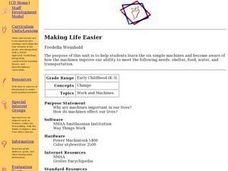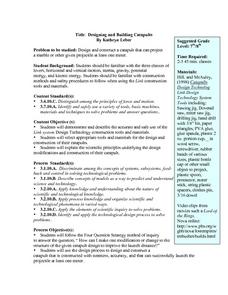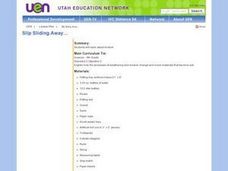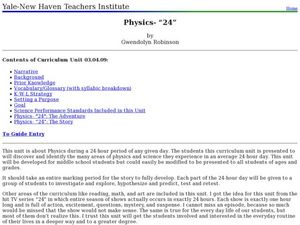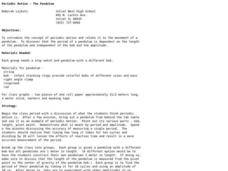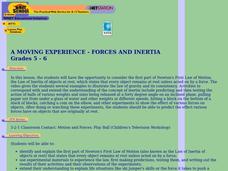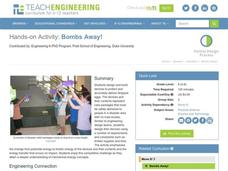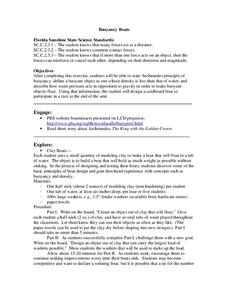Curated OER
Flight
Students are introduced to the four forces of flight--drag, lift, thrust, and weight--through a variety of fun-filled flight experiments. They "fly" for short periods and evaluate factors that might either increase or decrease their...
Curated OER
Making Life Easier
Students use a chart of the six simple machines and become aware of how the machines improve our ability to meet the following needs: shelter, food, water, and transportation. Students use model cars to experiment with force. They divide...
Curated OER
Exploring Pendulums
In this exploring pendulums activity, learners experiment with pendulums they make in the lab. They vary the length of the strings and the weights to observe the changes in the pendulum's amplitude and frequency. They answer 3 analysis...
Curated OER
Designing and Building Catapults
Seventh graders complete a challenge to create a catapult that projects a marble or other projectile at least one meter. While experimenting they apply the Four Question Strategy to answer the question, " How can I make one modification...
Curated OER
Weathering Rocks
Fourth graders investigate what natural events cause rocks to break apart and differentiate between erosion and weathering. They conduct an experiment with plaster of paris to observe why some rocks are hard and others break, and...
Curated OER
Erosion: Slip Sliding Away
Fourth graders investigate the causes of erosion. Through several demonstrations including one using sugar cubes and warm water, they observe the effects of erosion. In groups, 4th graders conduct similar experiments and record their...
Curated OER
Simulating the Greenhouse Effect in a Terrarium
Students identify what factors effect global warming and how the greenhouse effect occurs. In this environmental lesson students view videos then complete an experiment using a terrarium to observe greenhouse gas.
Curated OER
Physics "24"
Young scholars construct a model house or school. In this physics instructional activity, students research about who wind up clocks work and write an essay about it. They determine the center of gravity of different objects.
Curated OER
Animal Behavior
Students investigate stimulus-response behavior, learned behavior in animals and innate behavior in animals. In this animal behavior lesson plan, students answer questions about their reactions to a toy cap gun that is fired off in...
Curated OER
Periodic Motion - The Pendulum
Learners experiment to determine the period of a pendulum. In this periodic motion instructional activity, students use different pendulums to determine their periods. They use various amplitudes to determine its effects on the period.
Curated OER
Animals Up!
Students design and build a pedestal or platform that holds a toy animal. In this building lesson, students use knowledge from a prior lesson as they build a platform or pedestal for a toy animal using on index cards. They learn the...
Curated OER
Energy Activities
Learners conduct a variety of experiments related to solar energy, heating, cooling, gravity, physical insulation and wind. They consider how the experiments relate to energy and the consumption of energy and then participate in a class...
Curated OER
Newton's Laws
Beginning with definitions of mass and foce, this excellent set of slides summarizes Newton's Laws of motion and universal bravitaions. Components of each law are explained along with examples and questions to inspire discussion. This is...
Curated OER
A Moving Experience - Forces and Inertia
Students view a video and complete corresponding activities to observe inertia. They observe and predict the effect various forces have on objects.
San Francisco Public Utilities Commission
What is Groundwater? Our Underground Water Supply
Learn about the consequences of groundwater with a lesson about the different ways California handles water conservation and pollution. After reading a passage about the water table, learners apply what they have read to six...
Curated OER
The Methods of Biology
In this biology methods activity, students will explore the scientific method, including creating a hypothesis and setting up an experiment. This activity has 3 short answer questions, 5 matching questions, and 8 fill in the blank...
Curated OER
Motion and Force
This physics PowerPoint defines the concepts of motion and force. The slideshow consists of an explanation on how motion and force work and give students the chance to demonstrate motion and force through an experiment. The directions...
Curated OER
Forces and Graphing
Students analyze graphs to determine relationships between variables and rates of change. They determine the basic concepts about static reaction forces. They determine the slope and equation of a line.
Curated OER
Shoot for the Moon
Second graders distinguish the different phases of the moon. In this astronomy lesson, 2nd graders study the history of its discovery and myths about its origin. They simulate how the moon's surface is illuminated by the sun.
Curated OER
Newton's Laws of Motion
For this physics worksheet, students examine Newton's Laws of Motion by completing 4 different mini labs and answering follow-up questions for each lab.
Curated OER
Bombs Away!
Students design and build a device to protect and accurately deliver a dropped egg. They review and study a number of vocabulary words that are associated with this lesson. They work in a small group in order to develop a successful...
Curated OER
Understanding the Four Forces of Flight
In this four forces of flight activity, students read a 1 page article on flights, answer 5 questions with multiple choice answers, draw a line to connect the four forces to their definitions and answer 1 short answer scenario.
Curated OER
Circle of Pong
Students, in groups, use given materials to devise a way to deposit a ping-pong ball into a paper cup that is located in the middle of a 6-foot diameter circle, while standing outside the circle.
Center for Precollegiate Education and Training
Buoyancy Boats
What did the sea say to the boat? Nothing, it just waved. An inquiry-based instructional activity starts with a simple concept on the Archimedes Principle and challenges pupils to make something out of clay that floats....



